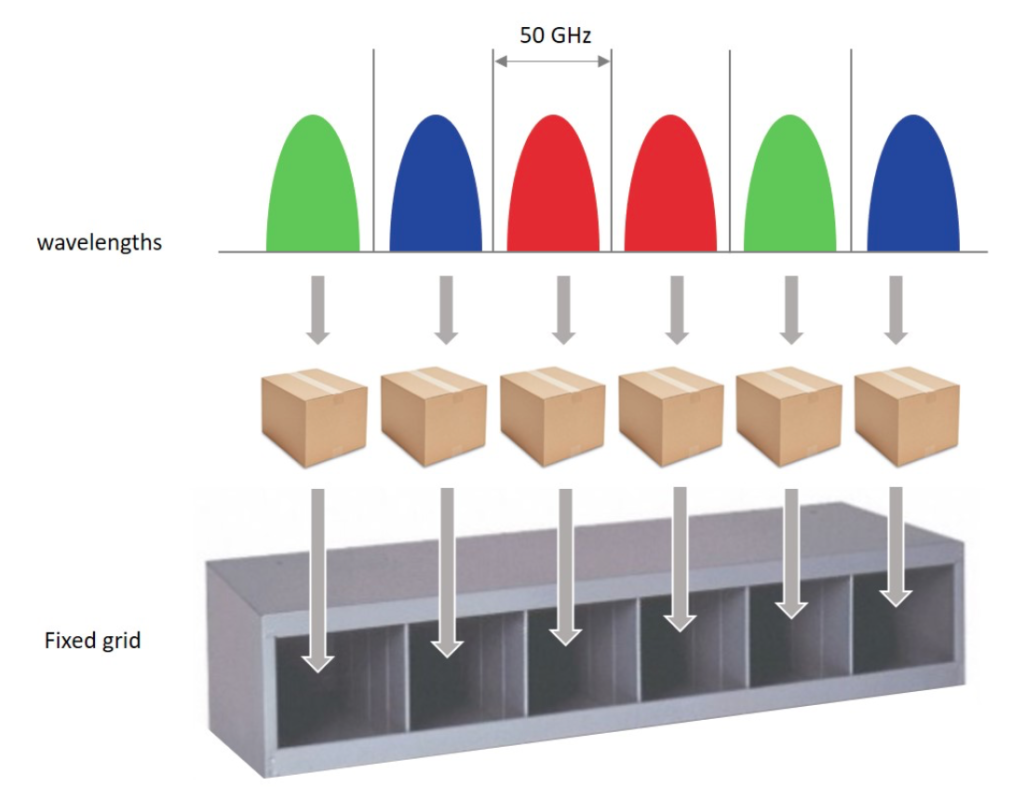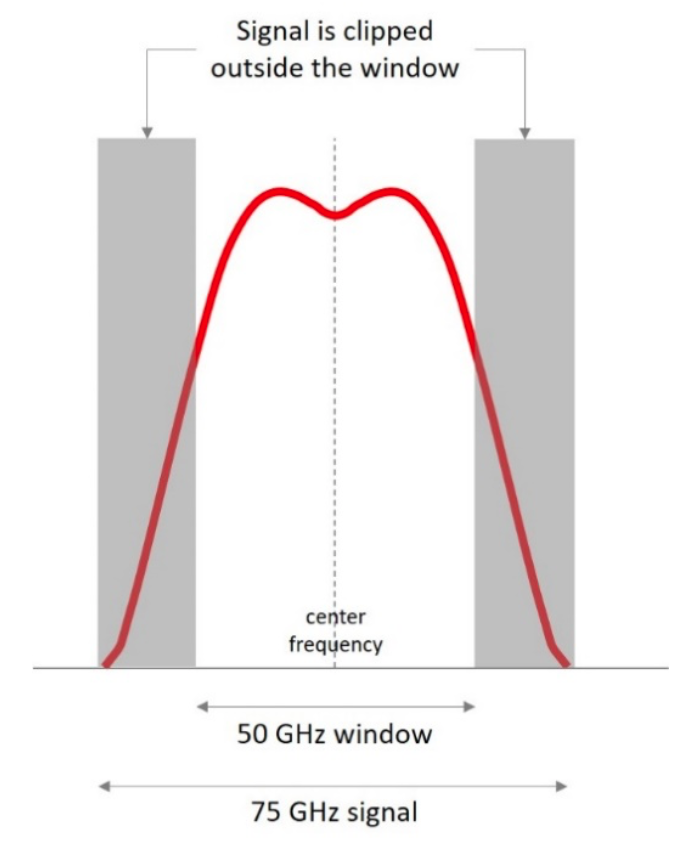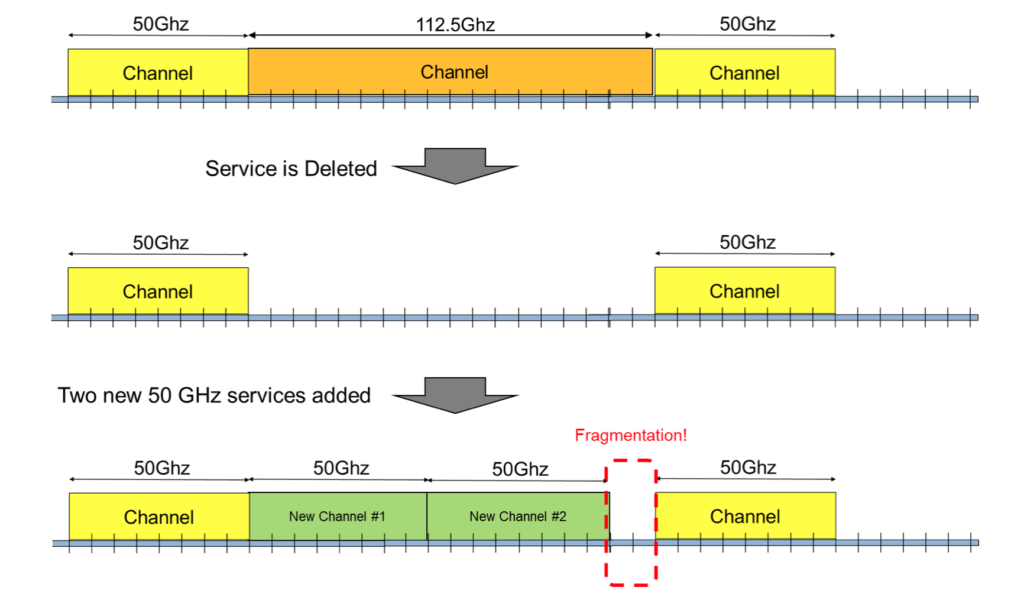The ROADM Tutorial Blogs, part 1

In this series of tutorials, I explain the key functionality (and their benefits) that underpin next-generation ROADMs: Colorless, Directionless, Contentionless, and Gridless (CDC-G) functionality.
In this blog, I explain the “G” in CDC-G – Gridless – and the operational benefits it provides.
My previous blog discussed the advantage of increasing the baud rate of a wavelength in order to increase transport capacity without sacrificing reachable distance. One drawback of this approach is the fact that the spectral width of the wavelength increases from 50 GHz to either 75 GHz, 100 GHz or even 150 GHz depending on the selected baud rate. The increase in spectral width can, in some cases (such as for older ROADM systems), become an obstacle to the successful transmission of the wavelength across the network.
This lies in the fact that the first few generations of ROADM systems were built around a fixed grid system where every wavelength was assigned a spectral width of 50 GHz. The ROADM system carved the optical band into 88 or 96 neatly spaced 50 GHz “cubbyholes” where each wavelength could be mapped.

This was perfectly appropriate for earlier generation of transponders where every wavelength had the same baud rate – each wavelength could neatly fit into one space in the C-band spectrum row of cubbyholes.
Optical spectrum is like cubbyholes, and wavelengths are boxes
To reuse the parcel delivery analogy of the previous blog, this is analogous to a van delivering parcels where every parcel is packed using a single box size. All the boxes are the same standard size and therefore, the cargo space in the delivery van can be divided into fixed cubbyholes to accommodate boxes of the same size.
Now, this simple arrangement is being disrupted by the emergence of optical transponders using different baud rates. The boxes are no longer fixed, but may be different sizes. ROADM systems are being provided with wavelengths of various sizes – all of them wider than 50 GHz … starting with 75 GHz for the last few years and wider wavelengths are on the horizon …
What happens when you try to transport a 75 GHz wide wavelength through an older 50 GHz fixed grid system?

The parcel delivery analogy provides a nice visualization of this scenario. The 75 GHz wavelength is a larger box being squeezed and stuffed into a 50 GHz sized cubbyhole but in the end, this will likely damage the larger box and the goods will not arrive intact at their destination.
The same will occur to the wavelength. The signal will be sent through the 50 GHz opening but any of the spectral content outside of the 50 GHz window will be filtered out. Both ends of the spectral content of the signal will be “clipped”. This will cause a poor signal quality, leading to transmission errors and this is clearly not acceptable.

Flex-grid makes the optical spectrum flexible
This is where Flex-grid becomes useful. This functionality is included in essentially every next generation ROADM system. Fujitsu has introduced flexible grid capability to the FLASHWAVE 9500 and it is also supported in our new 1FINITY™ L100 and 1FINITY L130 ROADM blades.
Flex-grid removes the fixed cubbyhole walls and lets the service provider define the spectral width of each wavelength independently. The optical spectrum is no longer pre-partitioned into 96 fixed slots of 50 GHz but rather a continuous 4,800 GHz wide block of spectrum. The service provider can carve individual spectral slots to meet the spectral width of each individual wavelength.
Using the parcel analogy, this is like retrofitting the delivery van with adjustable shelves and partition walls so that the cargo space can securely hold boxes of different sizes.
This provides the ultimate flexibility while ensuring that boxes of any size can be delivered to their destination without any damage.

Returning to the optical domain, the emergence of Flex-grid allows the service provider to carve the optical spectrum of their fiber to transport wavelengths of various spectral widths.

Flex-grid provides a granular resolution of 12.5 GHz
Flex-grid offers service providers the ability to define individual spectral widths for each wavelength, but a few basic guidelines must be followed:
- The channel’s spectral width must be a multiple of 12.5GHz. This is commonly referred to as “n x 12.5 GHz”. For example, a wavelength can be assigned a spectral width of:
- 37.5 GHz = 3 x 12.5 GHz
- 75.0 GHz = 6 x 12.5 GHz
- One cannot request a wavelength which is say 45 GHz or 57 GHz because these are not multiples of 12.5 GHz.
- The channel’s center frequency has to be located on a fixed grid with 6.25 GHz spacing. This means that every channel’s center frequency is located on fixed, pre-assigned positions located 6.25 GHz from each other.

- Defining a channel is as simple as specifying a center frequency and a spectral width. The ROADM will then reserve this channel and remove this space from its “spectrum inventory”.
- Perhaps the most basic rule is that adjacent channels cannot overlap. While the ROADM software typically manages spectrum allocation and automatically prevents overlaps, Flex-grid allows for manual spectrum planning so the age-old maxim of “Measure twice, cut once” (i.e. double-check the numbers) should be taken to heart.
Spectrum planning with Flex-grid
The flexibility of Flex-grid offers a great benefit but it can also be a bit of a double edge sword. If channel assignment is not properly planned, it can lead to stranded spectrum within the optical band.
Wavelengths typically require at least a 50 GHz spectral width in order to provide a minimum of 100 Gb/s capacity over a typical metro DWDM network. An operator should be careful in ensuring that they are not leaving unassigned spectrum components between wavelengths that are not at least 50 GHz. The presence of small slices of unusable spectrum is commonly referred to as “spectrum fragmentation”.
The emergence of unusable stranded spectrum can actually occur over time. Optical circuits are dynamically created and deleted and this dynamic nature can unintentionally create spectrum fragmentation.
For example, the latest generation of transponders are using 90 Gbaud technology. This baud rate typically has to be mapped into a 112.5 GHz (9 x 12.5 GHz) wide channel. If this wavelength is deleted, the system will recover this spectral space and reuse it in the future.
The spectral width is difficult to reuse without creating spectral segmentation. It can be reused as:
- Two 50 GHz wavelengths, leaving 12.5 GHz of unusable spectrum
- One 75 GHz wavelength, leaving 37.5 GHz of unusable spectrum
Over time, these circuit replacements will increase the likelihood of developing a fragmented spectrum, which leads to inefficiencies.

One approach commonly used is to limit the spectral widths used within a network to 50 GHz, 75 GHz and 100 GHz in order to reduce the likelihood of spectrum fragmentation. However, this approach has the consequence that the network has to be optimized around 30 Gbaud and 60 Gbaud transponders.
Many years ago, service providers started deploying Flex-grid capable ROADM systems anticipating that sooner or later, high baud rate wavelengths would be deployed, thus requiring a flexible grid infrastructure to accommodate their wider spectral widths. Today, Flex-grid ROADMs and optical networks are commonplace and they continue to evolve as a means to expand the capacity of optical fiber cable beyond 96 channels.
Are you migrating to a Flex-grid, or deploying higher speed circuits? Contact us to talk in-depth with one of our technical experts, or learn more about the Fujitsu 1FINITY Lambda series of ROADM and amplifier blades.